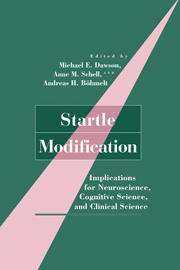Book contents
- Frontmatter
- Contents
- Contributors
- Preface
- Prologue: A Historical Note on the “Discovery” of Startle Modification
- 1 Startle Modification: Introduction and Overview
- PART I BASIC PARADIGMS, METHODS, AND PHENOMENA
- 2 Startle Elicitation: Stimulus Parameters, Recording Techniques, and Quantification
- 3 Short Lead Interval Startle Modification
- 4 Long Lead Interval Startle Modification
- PART II PHYSIOLOGICAL MEDIATION OF STARTLE MODIFICATION
- PART III PSYCHOLOGICAL MEDIATION OF STARTLE MODIFICATION
- PART IV INDIVIDUAL DIFFERENCES AND STARTLE MODIFICATION
- PART V RELATIONSHIPS WITH OTHER PARADIGMS AND MEASURES
- References
- Author Index
- Subject Index
4 - Long Lead Interval Startle Modification
Published online by Cambridge University Press: 26 March 2010
- Frontmatter
- Contents
- Contributors
- Preface
- Prologue: A Historical Note on the “Discovery” of Startle Modification
- 1 Startle Modification: Introduction and Overview
- PART I BASIC PARADIGMS, METHODS, AND PHENOMENA
- 2 Startle Elicitation: Stimulus Parameters, Recording Techniques, and Quantification
- 3 Short Lead Interval Startle Modification
- 4 Long Lead Interval Startle Modification
- PART II PHYSIOLOGICAL MEDIATION OF STARTLE MODIFICATION
- PART III PSYCHOLOGICAL MEDIATION OF STARTLE MODIFICATION
- PART IV INDIVIDUAL DIFFERENCES AND STARTLE MODIFICATION
- PART V RELATIONSHIPS WITH OTHER PARADIGMS AND MEASURES
- References
- Author Index
- Subject Index
Summary
ABSTRACT
In this chapter we review typical paradigms employed in investigations of startle modification at long lead intervals. We also summarize some of the basic phenomena associated with long lead interval startle modification. Such phenomena include the facilitation or inhibition of startle magnitude as a function of lead stimulus intensity and duration, cardiac deceleration, the modalities of the lead stimulus and the startle probe, whether participants are instructed to attend to or ignore the lead stimulus, and the emotional valence and arousal of the lead stimulus. Both relevant animal and human studies are reviewed, some of which have appeared previously only in doctoral dissertations. In addition, we discuss some of the conceptual issues that have driven much of this research, highlighting particular controversies that have received more attention, such as whether the relationship between lead stimulus intensity and startle amplitude is actually an inverted-U function, and what are the relative contributions of attentional and emotional processes in long lead startle modification.
Introduction
A burst of sound punctures the empty silence. Though brief, the noise burst is sufficiently intense to startle the hearer, producing a reflex blink. Now imagine that instead of being superimposed on silence, the noise burst follows a prior stimulus of several seconds duration – what we will refer to in this chapter as a “long lead stimulus.” What effect will that lead stimulus have on the hearer's startle blink to the subsequent noise burst? Will it mask the noise burst and thus attenuate the startle response? Will it summate with the noise burst and thus facilitate the reflex blink? Will it arouse and alert the listener, enhancing the reflex?
Information
- Type
- Chapter
- Information
- Startle ModificationImplications for Neuroscience, Cognitive Science, and Clinical Science, pp. 72 - 92Publisher: Cambridge University PressPrint publication year: 1999
Accessibility standard: Unknown
Why this information is here
This section outlines the accessibility features of this content - including support for screen readers, full keyboard navigation and high-contrast display options. This may not be relevant for you.Accessibility Information
- 12
- Cited by
